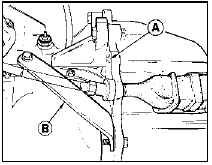Engine - removal leaving manual gearbox in vehicle
Note: The air conditioning system should always be discharged by a Ford dealer or air conditioning specialist.
Note: Refer to the warning in Section 8 before proceeding. A suitable hoist and lifting tackle will be required for this operation.
1 Disconnect the battery negative lead.
2 Remove the bonnet.
3 On carburettor models remove the air cleaner.
4 On fuel injection models, disconnect the crankcase ventilation hose from the air inlet hose, then disconnect the air inlet hose from the throttle body. Depress the locking clip on the airflow meter wiring plug and disconnect the plug (pulling on the plug, not the wiring) then release the four securing clips and lift off the air cleaner lid with the airflow meter and air inlet hose.
5 Remove the four retaining clips and unscrew the two retaining screws, then withdraw the upper section of the cooling fan shroud from the radiator. Unclip and remove the lower section of the shroud.
6 Remove the thermo-viscous cooling fan as described in Chapter 3.
7 Drain the cooling system.
8 Disconnect the upper radiator hose and where applicable, the expansion tank hose from the thermostat housing.
9 Disconnect the coolant hoses from the coolant pump, and where applicable from the inlet manifold and automatic choke. Unclip the coolant hose from the bracket on the exhaust manifold hot air shroud/heat shield, or the camshaft cover, as applicable.
10 On carburettor models, where applicable disconnect the vacuum pipe from the engine management module.
11 Disconnect the brake servo vacuum pipe from the inlet manifold.
12 On carburettor models, disconnect the fuel hoses from the carburettor and where applicable the mechanical fuel pump and plug the ends of the hoses to minimise petrol spillage. Remember to take adequate fire precautions.
13 On fuel injection models, disconnect the fuel feed line from the fuel pressure regulator, then disconnect the fuel supply hose from the fuel rail. Position a suitable container beneath the pressure regulator, then slowly loosen the fuel feed union to relieve the pressure in the fuel lines before disconnecting the union.
Take adequate fire precautions. Plug the ends of the hoses to minimise petrol spillage.
14 Disconnect the throttle cable, and where applicable remove its bracket.
15 Disconnect the HT lead from the ignition coil.
16 Disconnect the wiring from the following
components as applicable depending on
model:
Alternator
Starter motor
Distributor
Oil pressure warning lamp switch
Temperature gauge sender
Engine coolant temperature sensor
Automatic choke
Automatic choke pull-down solenoid
Carburettor anti-dieselling valve
Inlet manifold heater
Carburettor stepper motor
Fuel injection harness
Dipstick
17 Where applicable, detach the power
steering pump from the cylinder block and
move it to one side.
18 Unscrew and remove the top engine-togearbox bolts which are accessible from the engine compartment. Note the location of the earth strap on one of the bolts.
19 Note the location of the earth strap on the rear inlet manifold stud, then remove the nut and disconnect the strap.
20 Apply the handbrake (if not already done), jack up the front of the vehicle and support on axle stands (see “Jacking and Vehicle Support”).
21 Drain the engine oil into a suitable container.
22 Remove the starter motor.
23 Remove the exhaust downpipe.
24 Unscrew the nuts or bolts, as applicable, securing the engine mountings to the crossmember. Recover the washers.
25 Unscrew and remove the remaining engine-to-gearbox bolts, and remove the bolt from the engine adapter plate (see illustration).

9.25 Engine adapter plate bolt (A) and engine-to-gearbox brace (B)
26 Remove the two securing bolts and disconnect the engine-to-gearbox brace from the engine and gearbox.
27 Working inside the vehicle, place a wooden block under the clutch pedal to raise it fully against its stop which will hold the automatic adjuster pawl clear of the toothed quadrant.
28 Disconnect the clutch cable from the clutch release arm, and pass the cable through the bellhousing. Where applicable, remove the clip securing the clutch cable to the right-hand engine mounting bracket. Note the cable routing for use when refitting.
29 Lower the vehicle to the ground, and support the gearbox with a trolley jack, using a block of wood between the jack and the gearbox to spread the load.
30 Make a final check to ensure that all relevant wires, pipes and hoses have been disconnected to facilitate engine removal.
31 Attach a suitable hoist to the engine lifting brackets located at the front and rear of the cylinder head, and carefully take the weight of the engine. The engine should be supported horizontally, ie do not allow it to tilt front to rear.
32 Raise the engine until the engine mountings are clear of the crossmember then pull the engine forwards to disconnect it from the gearbox. Ensure that the gearbox is adequately supported, and take care not to strain the gearbox input shaft. It may be necessary to rock the engine a little to release it from the gearbox.
33 Once clear of the gearbox, lift the engine from the vehicle, taking care not to damage the radiator fins.
See also:
Ford Sierra Service and Repair Manual
Introduction to the Ford Sierra
The Ford Sierra was first introduced in late 1982 with the option of
seven different engines and four different trim levels. This manual
covers the four cylinder in- ...
Front brake disc - inspection, removal and refitting
Note: Before starting work, refer to the
warning at the beginning of Section 2
concerning the dangers of asbestos dust.
Inspection
1 Fully apply the handbrake then loosen the
front roadwheel bolt ...
Interior pillar trim panels - removal and refitting
Front pillar
1 Remove the two trim panel securing screws
and withdraw the panel (see illustration)..
41.1 Interior pillar trim panel fixings - Hatchback models
A Front pillar trim panel
B1 Cent ...
